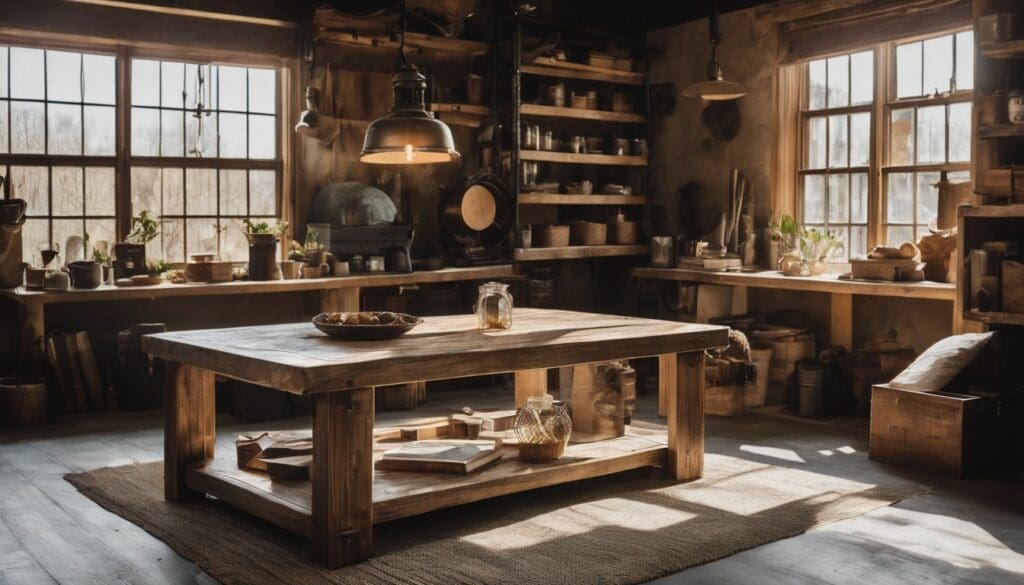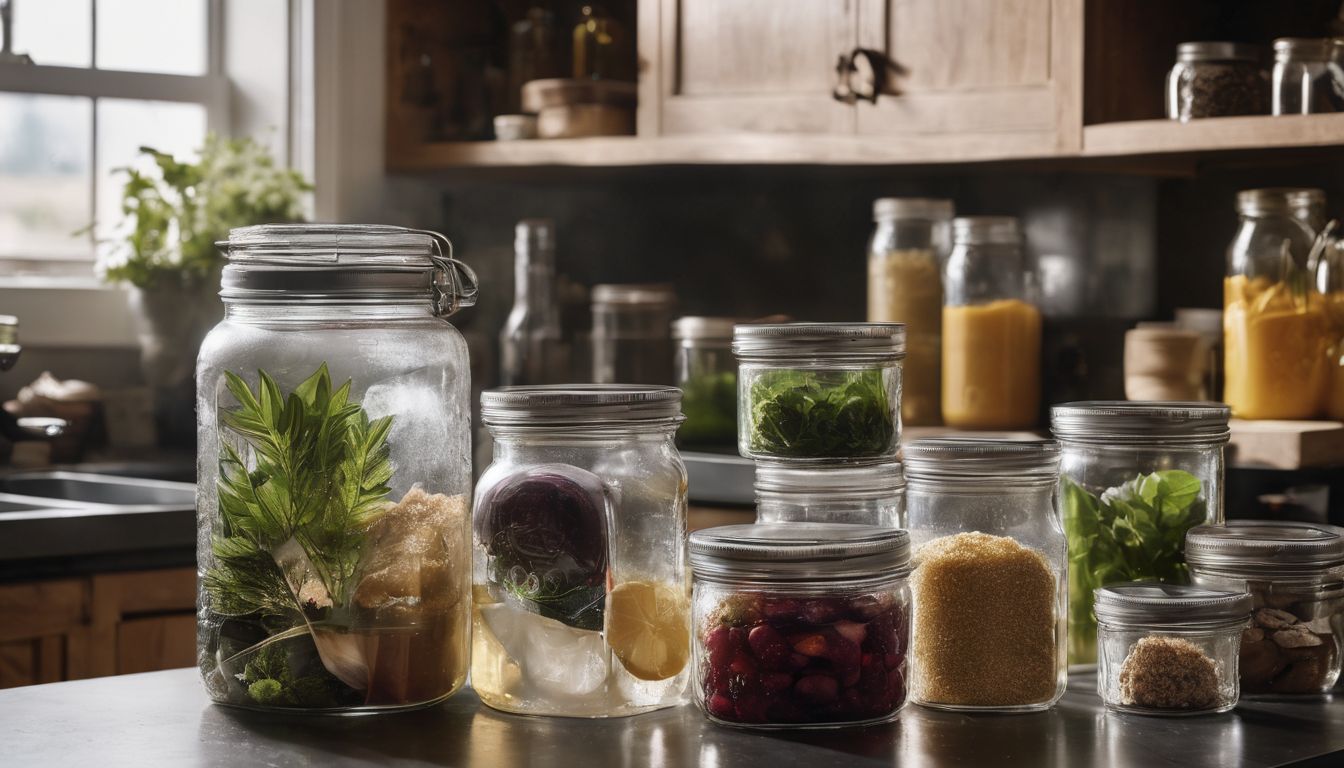Finding the right furniture that’s both stylish and kind to our planet can be tough. Every year, heaps of discarded furnishings add to landfill woes. This article will guide you through crafting your own sustainable pieces, cutting waste without sacrificing charm.
Let’s create beauty that lasts!
Key Takeaways
- Building eco – friendly furniture using sustainable materials like reclaimed wood or bamboo helps preserve natural habitats and reduces waste, supporting a healthier planet.
- Employing natural finishes and avoiding chemicals in DIY projects ensures safer indoor air quality and a more sustainable approach to crafting furniture.
- Opting for durable, long-lasting materials such as FSC-certified wood contributes to less environmental depletion and supports responsible consumerism.
- Regular maintenance of eco – friendly furniture extends its lifespan, reducing the need for replacements and promoting a culture of sustainability.
- By engaging with sustainable organisations and adopting green practices in furniture building, individuals can actively participate in preserving the global ecosystem.
Why Build Eco-Friendly Furniture?
Building eco-friendly furniture is essential to reduce our environmental impact, use sustainable materials, and support a greener future. It promotes responsible consumption and supports a healthier planet for future generations.
Reduce environmental impact
Crafting your own furniture with sustainable materials is a direct strike against deforestation and pollution, two major environmental threats. By selecting wood from responsibly managed forests or reclaimed sources, you support the preservation of natural habitats and reduce waste.
Opt for recycled metals and plastics to keep them out of landfills and oceans. Less new material means a smaller carbon footprint.
Employing ecofriendly design principles in your DIY projects contributes positively to cleaner air and water. Choose natural finishes free from volatile organic compounds (VOCs) that can harm the atmosphere and your health.
Ditch synthetics for biodegradable options that won’t linger on Earth long after their use. Every green choice you make while building reinforces an environmentally conscious lifestyle, paving the way for a healthier planet.
Use sustainable materials
Crafting eco-friendly furniture begins with using sustainable materials. Opt for renewable options such as bamboo or reclaimed wood, which minimise environmental impact and support conservation efforts.
Consider recycled materials for a unique touch and to reduce the demand on natural resources. Choose biodegradable finishes and paints to further enhance the eco-conscious nature of your furniture.
By selecting sustainable materials, you contribute to a greener future and demonstrate your commitment to environmentally friendly practices in furniture building.
Building durable and eco-friendly furniture is achievable by choosing sturdy, long-lasting sustainable materials that align with your values as an environmentally conscious individual.
Support a greener future
By utilising sustainable materials in furniture building, individuals can support a greener future. Using renewable resources such as wood or bamboo helps reduce environmental impact and promotes eco-conscious living.
Additionally, incorporating natural finishes and paints for furniture construction contributes to the overall effort of supporting conservation and environmental sustainability.
Choosing eco-friendly DIY projects that involve salvaged wood or upcycled materials further supports a greener future. By opting for environmentally conscious furniture options, individuals can make a positive impact on the global ecosystem and promote sustainable living practices within their communities.
Principles of Sustainable Furniture Design
Sustainable furniture design focuses on using renewable materials, avoiding harmful chemicals and toxins, and prioritising minimalism and functionality in the design process. This helps to reduce environmental impact while creating long-lasting and eco-friendly furniture pieces.
Use of renewable materials such as wood or bamboo
To build eco-friendly furniture, consider using renewable materials such as wood or bamboo. These materials are sustainable, renewable, and have lower environmental impact compared to non-renewable resources.
By opting for wood or bamboo, you contribute to the conservation of natural resources and promote a greener future. Additionally, these materials can be sourced responsibly and often support local communities involved in their production.
Moreover, choosing wood or bamboo aligns with sustainable living concepts and supports environmentally friendly furniture design. Incorporating these renewable materials into your DIY sustainable furniture projects helps reduce the demand for non-renewable resources while promoting eco-conscious interior design and green living practices.
Avoid harmful chemicals and toxins
Choose eco-friendly materials that are free from harmful chemicals and toxins, ensuring a safe environment for your home or office. Utilise natural finishes and paints to minimise exposure to volatile organic compounds (VOCs) and other pollutants, promoting better indoor air quality.
Opt for renewable materials like wood or bamboo, which not only reduce environmental impact but also provide a healthier living space for you and your family.
By avoiding harmful chemicals and toxins in furniture building, you contribute to a cleaner and more sustainable future while safeguarding the well-being of our planet. The use of eco-friendly materials will help create a healthier environment inside your home or workspace, supporting green living concepts with each piece of furniture crafted.
Minimalism and functionality
When designing eco-friendly furniture, embracing minimalism and functionality is key. By incorporating clean lines and simple designs, you can reduce waste and create pieces that serve a purpose without unnecessary clutter or adornments.
Focusing on functionality ensures that each item not only looks good but also serves a practical function, promoting a sustainable lifestyle. Consider using multi-purpose furniture or pieces with built-in storage to maximise space efficiency while maintaining an environmentally friendly approach.
To achieve this, opt for timeless designs that will outlast trends and remain relevant for years to come. Embracing minimalism in your furniture choices can lead to less consumption of resources while still creating aesthetically pleasing and functional pieces.
Eco-Friendly Materials for Furniture Building
Explore sustainable wood options, recycled materials, and natural finishes to build eco-friendly furniture that supports a greener future. Read on to discover the best materials for your DIY project!
Sustainable wood options
Sustainable wood options are an essential choice for eco-friendly furniture. By using sustainable wood, you contribute to preserving forests and reducing environmental impact.
- Reclaimed Wood: Salvaged from old structures or furniture, this wood is given a new life, reducing the need for fresh logging and saving trees.
- Bamboo: A rapidly renewable resource that grows quickly without the need for pesticides or fertilisers, making it an eco-friendly alternative to traditional wood.
- FSC-Certified Wood: Look for materials certified by the Forest Stewardship Council (FSC), ensuring responsible forest management and ethical sourcing practices.
- Cork: Harvested from the bark of cork oak trees without harming them, cork is a durable and versatile material suitable for various furniture applications.
- Teak: Known for its durability and resistance to decay, teak is often sourced from sustainably managed plantations, making it an environmentally conscious choice.
Recycled materials
- Repurposed wood: Utilise reclaimed wood from old furniture, pallets, or construction sites for a unique and sustainable touch.
- Upcycled metal: Incorporate salvaged metal elements such as old pipes or industrial fixtures to add character and durability to your furniture pieces.
- Reclaimed fabric: Source vintage textiles or repurpose old clothing into upholstery material for a distinct eco-friendly look.
- Recycled plastic: Utilise recycled plastic materials to create sturdy and long-lasting components for your furniture designs.
- Repurposed glass: Incorporate reclaimed glass elements into your furniture designs, reducing the demand for new production while adding a sleek and modern touch.
Natural finishes and paints
Using natural finishes and paints for your eco-friendly furniture is crucial to reducing harmful chemical emissions. These materials promote a healthier indoor environment and support sustainable forestry practices. Consider using options such as plant-based oils, beeswax, and water-based paints for a greener approach to finishing your furniture.
- Plant-Based Oils: These oils, like linseed or tung oil, provide a natural and non-toxic finish for wood surfaces. They enhance the natural beauty of the material while offering protection against moisture and wear.
- Beeswax: Beeswax provides a lustrous finish while nourishing the wood’s surface. It’s a sustainable option that creates a protective layer without releasing harmful fumes into the environment.
- Water-Based Paints: Low in volatile organic compounds (VOCs), water-based paints are an eco-friendly alternative to traditional solvent-based paints. They dry quickly, emit fewer pollutants, and come in a wide range of colours.
Tips for Building Durable and Eco-Friendly Furniture
Utilise proper construction techniques and choose sturdy, long-lasting materials for your eco-friendly furniture. Regular maintenance will also help to ensure its durability over time.
Proper construction techniques
To build durable and eco-friendly furniture, opt for proper construction techniques. Use joinery methods such as dovetail, mortise and tenon, or dowel joints to ensure structural integrity.
When assembling the furniture, employ non-toxic adhesives and finishes to minimise environmental impact. Choose sustainable fasteners like screws made from recycled materials, reducing waste and supporting a greener future.
Ensure that the furniture is built with precision and attention to detail to avoid unnecessary material wastage.
When constructing eco-friendly furniture, select sturdy materials that are long-lasting and ethically sourced. Utilise woodworking tools carefully to avoid damaging the environment while working with renewable wood or bamboo.
Choosing sturdy and long-lasting materials
Select durable and resilient materials for your eco-friendly furniture project. Opt for sustainably sourced wood, such as oak or maple, which can withstand daily use and last for generations.
Consider bamboo, known for its strength and rapid renewability. Additionally, explore recycled materials like reclaimed wood or metal to create unique and sturdy pieces that contribute to a greener future.
Look for natural finishes and paints free from harmful chemicals to ensure the longevity of your furniture while minimising environmental impact. Regular maintenance is crucial in preserving the beauty and functionality of your environmentally conscious creations; choose materials that are easy to maintain and repair when needed.
By choosing robust and long-lasting materials, you not only create eco-friendly furniture but also reduce the need for frequent replacements, ultimately lessening waste production.
Regular maintenance
Regular maintenance of your eco-friendly furniture is essential to ensure its longevity and continued positive impact on the environment. By performing routine checks and repairs, you can prevent unnecessary waste and contribute to a sustainable lifestyle.
Clean the surfaces with natural, non-toxic products to maintain their integrity without harming the environment. Additionally, periodic inspections allow for early detection of any issues that may arise, promoting the use of renewable materials instead of resorting to replacements.
Proper care also involves checking for loose joints or damage caused by wear and tear. Frequent dusting using biodegradable materials keeps your furniture looking great while preserving its eco-friendly characteristics.
Furthermore, applying a fresh coat of natural finishes can protect wood from environmental influences, contributing to a durable piece that aligns with your commitment to sustainability.
Supporting the Global Ecosystem through Furniture Building
By choosing to build eco-friendly furniture, you are contributing to the preservation of our global ecosystem. This can be achieved by giving back to the environment, supporting sustainable organisations, and adopting eco-friendly business practices.
Giving back to the environment
Choosing to build your own eco-friendly furniture is a proactive way to give back to the environment. By using sustainable materials like bamboo and recycled wood, you are reducing the demand for new resources, which in turn lessens deforestation and carbon emissions.
Additionally, choosing natural finishes and paints minimises harmful chemicals, creating a healthier indoor environment while also supporting the ecosystem.
Supporting sustainable organisations that promote environmental conservation through responsible sourcing of materials further contributes to protecting our planet. Embracing eco-friendly business practices within the woodworking industry can have a positive impact on global ecosystems by reducing waste, energy consumption, and pollution.
Supporting sustainable organisations
To support sustainable organisations, consider sourcing eco-friendly materials from companies with transparent and ethical practices. Look for certifications such as FSC or PEFC to ensure that the wood used in your furniture is sustainably harvested.
Additionally, seek out suppliers that prioritise environmentally responsible manufacturing processes and use recycled or upcycled materials in their products. By choosing to work with like-minded businesses, you can contribute to a greener future while creating beautiful and environmentally conscious furniture.
Supporting sustainable organisations involves more than just purchasing materials; it also means engaging in eco-friendly business practices yourself. This could include using energy-efficient tools and machinery, reducing waste through recycling and composting, or even offsetting your carbon footprint through partnerships with conservation projects.
Eco-friendly business practices
Supporting sustainable organisations goes hand in hand with implementing eco-friendly business practices. This involves sourcing materials and supplies from ethical and environmentally friendly suppliers, reducing energy consumption within the workspace, and recycling or repurposing waste materials to minimise environmental impact.
Additionally, adopting eco-conscious packaging and shipping methods further contributes to a sustainable business model, promoting environmental responsibility throughout all aspects of the furniture building process.
Eco-friendly business practices not only benefit the environment but also showcase a commitment to sustainability which can resonate with environmentally conscious consumers. By integrating these practices into your furniture building endeavours, you actively contribute towards a greener future while setting an example for others in the industry.
Conclusion
By building your own eco-friendly furniture, you contribute to reducing environmental impact. Sustainable materials and proper construction techniques ensure durability. Supporting the global ecosystem through eco-friendly practices furthers a greener future.
Through these principles, we can create a positive impact on our environment and support conservation efforts.
FAQs
1. What are sustainable materials I can use for eco-friendly furniture?
Sustainable materials for building your own eco-friendly furniture include renewable wood, recycled metals, and biodegradable substances that have a low environmental impact.
2. Can I make my home more green with DIY ecofriendly projects?
Yes, you can create an eco-conscious home by engaging in Ecofriendly DIY projects such as upcycling old pieces or making furniture using reclaimed resources.
3. Is it possible to design office furniture that’s both sustainable and stylish?
Absolutely! Sustainable office furniture not only supports the environment but also offers a modern look through its innovative use of green furniture materials.
4. How does choosing recycled furniture design help the planet?
Opting for recycled furniture design reduces waste and helps conserve natural resources, aligning with an eco-friendly lifestyle while creating unique pieces.
5. Are there any options for outdoor spaces that are environmentally friendly?
Indeed! You can select from a range of green outdoor furnishings including items made from repurposed wood or metal, contributing to a more sustainable exterior design.





